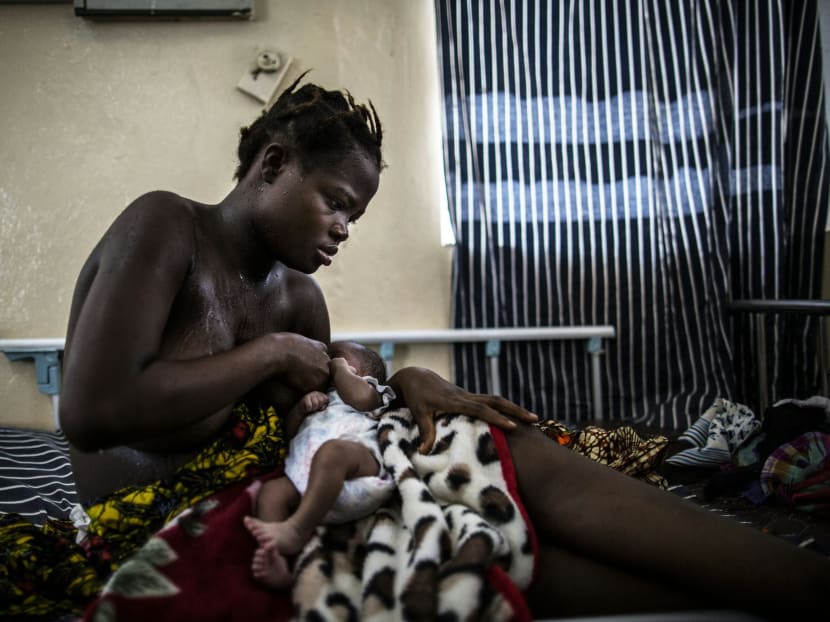Alone and at risk: Sierra Leone’s baby-faced mothers
FREETOWN (Sierra Leone) — Dizzy and sweating, 15-year-old Isatu Koroma sits with her eyes closed in the maternity ward in Sierra Leone where she has spent the last 10 days, as her tiny little daughter begins to cry.

Isatu Korom, 15-years-old breastfeeds her newborn at a ward of the Princess Christian Maternity Hospital in Freetown on April 25, 2016. Photo: AFP
FREETOWN (Sierra Leone) — Dizzy and sweating, 15-year-old Isatu Koroma sits with her eyes closed in the maternity ward in Sierra Leone where she has spent the last 10 days, as her tiny little daughter begins to cry.
Koroma badly needs blood after a complicated delivery — relatives are expected to donate here but none has visited, also leaving the nurses to pay for her to eat.
Health workers in the west African country are battling a teenage pregnancy epidemic that peaked when the Ebola crisis was at its height late in 2014, and they say it shows no sign of slowing.
Ward sister Josephine Samba describes the girl’s pregnancy as “an accident”, whispering that Koroma’s own mother died two months after she was born as she cajoles her into breastfeeding the as yet unnamed baby.
Schoolgirls are so regularly admitted to Princess Christian Maternity Hospital (PCMH) in Freetown that they attract little attention.
Coyness about discussing sex in Sierra Leone veils the fact that during the chaos of the Ebola crisis many teenagers were raped or forced to have sex for money to contribute to household expenses, according to research by several children’s charities and UN agencies.
“There were a lot more (teen pregnancies) during the Ebola breakout. Most of them were at home. There was no school, so everything was just upside down,” Ms Samba says.
After Sierra Leone announced its first Ebola cases in May 2014, schools were closed and movement severely restricted, leaving girls more vulnerable to abuse.
Since then the UN Population Fund (UNFPA) has counted more than 18,000 teenage pregnancies, with the number of pregnant girls up by 65 per cent in certain districts.
UNSAFE ABORTION
Internationally recognised as the country with the world’s highest maternal mortality rate, at 1,360 deaths per 100,000 live births, Sierra Leone could ill afford the blow to its health system that Ebola dealt, diverting resources and staff away from maternal health.
The result is thousands of girls who will never live to become women, as UNFPA estimates that 40 per cent of all maternal deaths occur among those under 18.
A lack of birth control and conservative abortion laws mean that many girls, upon realising they are pregnant and fearing they will be forced to drop out of school, attempt to abort with drugs or seek out backstreet providers who employ methods such as bicycle spokes to terminate pregnancies.
Ms Louise Nordstrom, a Swedish midwife working on a UNFPA training programme for birth attendants at the hospital, described a recent, typical case of a young student who arrived at PCMH with severe stomach pains.
“You could see she was in agony. I asked her if she knew she was pregnant,” Ms Nordstrom said, keeping one eye on a screaming woman waiting to be taken to theatre for an emergency cesarean section.
“Soon after she went to pee in a bed pan and out came the dead foetus. It was very obvious she had been taking some drugs at home; she knew she was pregnant; she was afraid and didn’t want to have the baby so she induced an abortion herself.”
Many girls wait until it’s far too late before seeking hospital care, says Dr Alimamy Philip Koroma (no relation to the teenage mother), one of Sierra Leone’s pre-eminent obstetric and gynaecology specialists.
“Some of them don’t even come to the antenatal clinic, they stay at home because of fear of their (school) colleagues seeing them,” he told AFP.
“Sometimes their pelvis is not prepared enough to have a child,” he said, also referring to hemorrhage and septicaemia as particular risks for girls arriving after attempting unsafe abortions.
SCHOOL DROPOUTS
In this difficult context, Dr Mohammed El Hassein, reproductive health specialist at UNFPA, said the three priorities were to improve progress in the uptake of family planning, bolster the image of midwives and ensure access to emergency obstetric care.
But the problem is particularly entrenched among young people.
“We are trying to train the (contraception) providers to be youth-friendly,” he told AFP.
And for those who survive childbirth, life choices are restricted.
The government has only recently allowed school-aged mothers to go back to class and many of those who do lack the support they need.
“Before the reopening of school the child was very small and on breast milk. There was no one to take care of her except me,” said Ms Neima Foday, 19, speaking to AFP in the town of Kailahun with 13-month-old baby Ishmail on her knee.
“I’m a bit worried because my friends are attending school and I’m not,” she said, adding that without an education she knew money would always be a problem.
Asked if Ishmail’s father was contributing to his son’s upkeep, Ms Foday shook her head.
“I haven’t seen him since I told him I was pregnant,” she said. AFP






